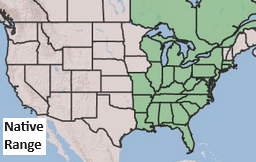Blazing Star
Liatris spicata
Click here to download a PDF of this plant information page (for printing).

Sun Exposure: Full Sun
Season of Interest: Spring, Summer, Fall
Bloom Time: June - July
Bloom Color: Purple
Height: 36 to 50 in.
Spread: 10 to 18 in.
Spacing: 24 in.
Water Needs: Average
Maintenance: Very little
Soil Type: Clay, Loam, Sandy
Soil pH: Acidic, Neutral
Soil Drainage: Well drianed
Pests: Somewhat deer resistant
Diseases: None
Wildlife: Bees, Butterflies, Hummingbirds

Description:
Blazing Star is a long-blooming perennial wildflower native to eastern North America. It is a member of the very large aster (Asteraceae) family of plants, but instead of the familiar daisy-like flowers of most plants in that family, Liatris has highly unusual flower heads featuring tiny star-like blossoms arranged around a long upright bottle-brush spire. It typically has bright purple flower spikes, but also occurs pink and white flowers. The grass like leaves are narrow and inconspicuous, forming in a basal clump. The foliage turns an attractive bronze color in the fall. For more information see: plants.ces.ncsu.edu/plants/liatris-spicata
plants.ces.ncsu.edu/plants/liatris-spicata
Care and Growing Tips:
Blazing Star requires very little care, but you may need to stake up the stems if planted in overly-rich soil, which can cause the plant to grow tall and floppy. Choose a site with full sun since these are prairie plants in their native habitat, so the more sun, the better they will perform. Just about any soil, at any level of fertility, will successfully grow this plant, although quick drainage is essential to prevent rot. Liatris plants prefer a slightly acidic to neutral soil pH. Heavy clay can cause root rot, especially in winter, if the soil doesn't drain well. Water thoroughly after transplanting. As the plants begin active growth, 1 inch of water a week during the hottest months will prevent stunted flowers and leaf scorch. Apply water to the base of the plants, or use drip irrigation, to avoid spreading fungal diseases. These plants need more water in their first year; afterward, they have very good tolerance to drought and dry soil conditions. Hardy in zones 3 to 9, Liatris is quite tolerant of summer heat and humidity in warm climates, and will nicely survive very cold winters provided that soil is not too wet. Blazing Star is not a heavy feeder, but if the soil fertility is extremely poor, you can apply a balanced flower fertilizer each spring as active growth begins. In most soils, however, it usually does fine with no feeding whatsoever.